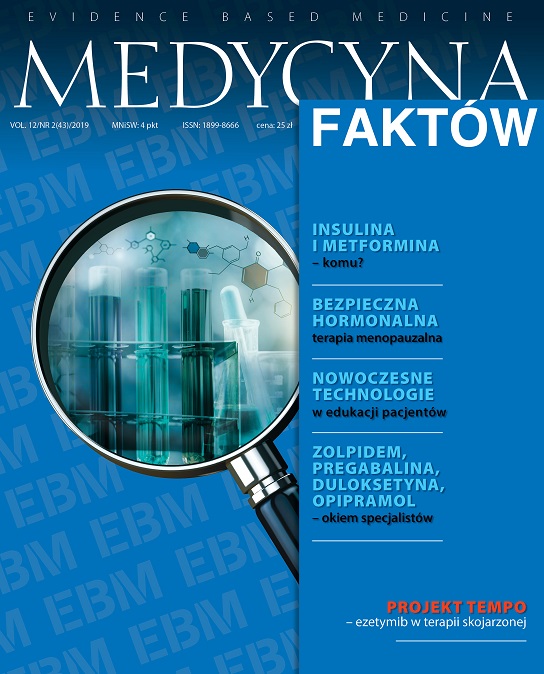Ivabradine – how do I currently use it in the treatment of heart failure? Review article
Main Article Content
Abstract
Ivabradine is indicated for the treatment of symptomatic patients with heart failure with reduced left ventricular ejection fraction, who are in sinus rhythm and whose resting heart rate is ≥ 70 b.p.m., despite treatment with an evidence-based or maximum tolerated dose of a β-blocker. There are increasing evidence that ivabradine can be safely used in various clinical situations. A recently published meta-analysis showed that the most effective drug combinations reducing mortality and frequency of hospitalization were schedules involving novel drugs such as ivabradine and sacubitril + valsartan (in addition to the β-blocker, angiotensin converting enzyme inhibitor, mineralocorticoid receptor antagonist therapy). Therefore, it is surprising that ivabradine, despite being recommended in the ESC guidelines since 2012, is so rarely used in Polish patients with indications for such treatment.
Article Details
Copyright © by Medical Education. All rights reserved.
References
2. Ponikowski P., Voors A.A., Anker S.D et al.: 2016 ESC Guidelines for the diagnosis and treatment of acute and chronic heart failure: The Task Force for the diagnosis and treatment of acute and chronic heart failure of the European Society of Cardiology (ESC). Developed with the special contribution of the Heart Failure Association (HFA) of the ESC. Eur. J. Heart Fail. 2016; 18: 891-975.
3. Yancy C.W., Jessup M., Bozkurt B. et al.: 2016 ACC/AHA/HFSA focused update on new pharmacological therapy for heart failure: an update of the 2013 ACCF/AHA Guideline for the Management of Heart Failure: a report of the American College of Cardiology/American Heart Association Task Force on Clinical Practice Guidelines and the Heart Failure Society of America. J. Am. Coll. Cardiol. 2016; 68: 1476-1488.
4. Laribi S., Aouba A., Nikolaou M. et al.: Trends in death attributed to heart failure over the past two decades in Europe. Eur. J. Heart Fail. 2012; 14: 234-239.
5. Ambrosy A.P., Fonarow G.C., Butler J. et al.: The global health and economic burden of hospitalizations for heart failure: lessons learned from hospitalized heart failure registries. J. Am. Coll. Cardiol. 2014; 63: 1123-1133.
6. Maggioni A.P., Orso F., Calabria S. et al.: The real-world evidence of heart failure: findings from 41 413 patients of the ARNO database. Eur. J. Heart Fail. 2016; 18: 402-410.
7. Komajda M., Cowie M.R., Tavazzi L. et al.: Physicians’ adherence to guideline‐recommended medications in heart failure with reduced ejection fraction: data from the QUALIFY global survey. Eur. J. Heart Fail. 2016; 18(5): 514-522.
8. Greene S.J., Vaduganathan M., Wilcox J.E. et al.: The prognostic significance of heart rate in patients hospitalized for heart failure with reduced ejection fraction in sinus rhythm: insights from the EVEREST (Efficacy of Vasopressin Antagonism in Heart Failure: Outcome Study With Tolvaptan) trial. JACC Heart Fail. 2013; 1(6): 488-496.
9. Logeart D., Seronde M.F., Degroote P. et al.: Raised heart rate at discharge after acute heart failure is an independent predictor of one-year mortality. Eur. Heart J. 2012; 33. Great Clarendon St, Oxford Ox2 6dp, England: Oxford Univ. Press.
10. Böhm M., Swedberg K., Komajda M. et al.: Heart rate as a risk factor in chronic heart failure (SHIFT): the association between heart rate and outcomes in a randomised placebo-controlled trial. Lancet 2010; 376(9744): 886-894.
11. Komajda M., Böhm M., Borer J.S. et al.: Efficacy and safety of ivabradine in patients with chronic systolic heart failure according to blood pressure level in SHIFT. Eur. J. Heart Fail. 2014; 16(7): 810-816.
12. Borer J.S., Böhm M., Ford I. et al.: Effect of ivabradine on recurrent hospitalization for worsening heart failure in patients with chronic systolic heart failure: the SHIFT Study. Eur. Heart J. 2012; 33(22): 2813-2820.
13. Bagriy A.E., Schukina E.V., Samoilova O.V. et al.: Addition of ivabradine to β-blocker improves exercise capacity in systolic heart failure patients in a prospective, open-label study. Adv. Ther. 2015; 32(2): 108-119. DOI: 10.1007/s12325-015-0185-5.
14. Hidalgo F.J., Anguila M., Castillo J.C. et al.: Effect of early treatment with ivabradine combined with beta-blockers versus beta-blockers alone in patients hospitalised with heart failure and reduced left ventricular ejection fraction (ETHIC-AHF): A randomised study. Int. J. Cardiol. 2016; 217: 7-11. DOI: 10.1016/j.ijcard.2016.04.136.
15. Komajda M., Böhm M., Borer J.S. et al.: Narastająca korzyść z leczenia farmakologicznego u pacjentów z przewlekłą niewydolnością serca z obniżoną frakcją wyrzutową lewej komory – metaanaliza sieciowa. Eur. J. Heart Fail. 2018; 20(9): 1315-1322. DOI: 10.1002/ejhf.1234.

